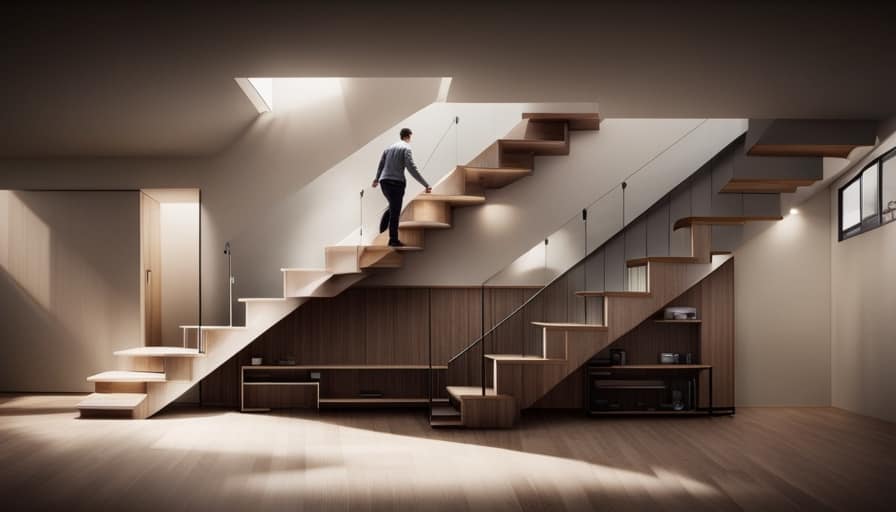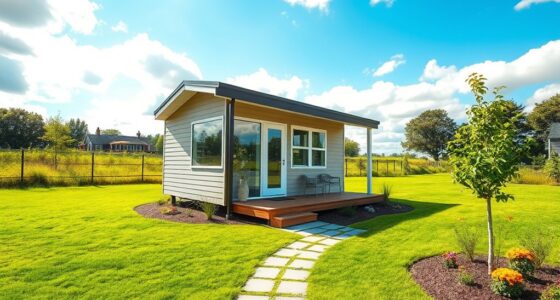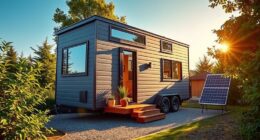Do you find yourself feeling swamped by the responsibilities of maintaining a large home? We understand the struggle. That’s why we’re here to offer our top 10 tips for living in a tiny house.
Living small doesn’t mean sacrificing your dreams; it’s about embracing simplicity and maximizing every inch of your space. In this article, we’ll guide you through innovative storage solutions, multi-functional design, and sustainable living practices.
Get ready to live big in a small space and make your dreams a reality.
Key Takeaways
- Utilize hidden storage options and creative storage solutions to maximize storage space.
- Look for innovative furniture solutions and space-saving furniture ideas.
- Embrace minimalism and balance aesthetics and functionality in the tiny house.
- Create outdoor living spaces that are functional and aesthetically pleasing.
Maximizing Storage Space
We can make the most of our storage space by utilizing creative solutions and thinking outside the box. In a tiny house, every inch counts, so it’s important to find innovative organization techniques to maximize storage.
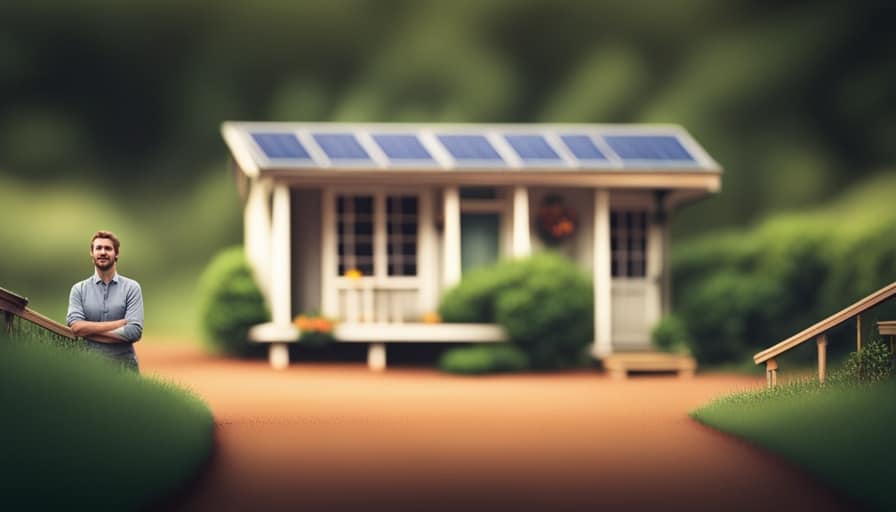
One way to achieve this is by utilizing hidden storage options. Look for furniture that doubles as storage, like ottomans with hidden compartments or beds with built-in drawers. Install shelves and hooks on the walls to make use of vertical space. Use under-bed storage containers to keep items out of sight but easily accessible. Utilize the backs of doors by hanging organizers or hooks.
Think creatively and consider unconventional storage solutions, like using a ladder as a bookshelf or repurposing old suitcases as storage containers. By implementing these strategies, we can create a clutter-free space that feels spacious and organized.
Innovative Furniture Solutions
When it comes to living in a tiny house, one of the biggest challenges is finding furniture that can maximize space. That’s where space-saving multipurpose furniture comes in.
By investing in pieces that serve multiple functions, such as a sofa that can transform into a bed or a coffee table that doubles as a storage unit, you can make the most of your limited square footage.

Additionally, getting creative with storage solutions, like using floating shelves or utilizing the space under your stairs, can help you keep your belongings organized and out of the way.
Space-Saving Multipurpose Furniture
Our tiny house living experience was greatly enhanced by using space-saving multipurpose furniture. These compact storage options and convertible furniture pieces allowed us to maximize every square inch of our small living space. Here are four innovative furniture solutions that made a big difference:
-
Wall-mounted drop-leaf table: This versatile piece provided us with a dining table when needed, and it could be easily folded up against the wall to save space.
-
Sofa bed with storage: Our living room doubled as a guest room with a sofa that transformed into a comfortable bed. The built-in storage underneath was perfect for storing extra bedding and pillows.
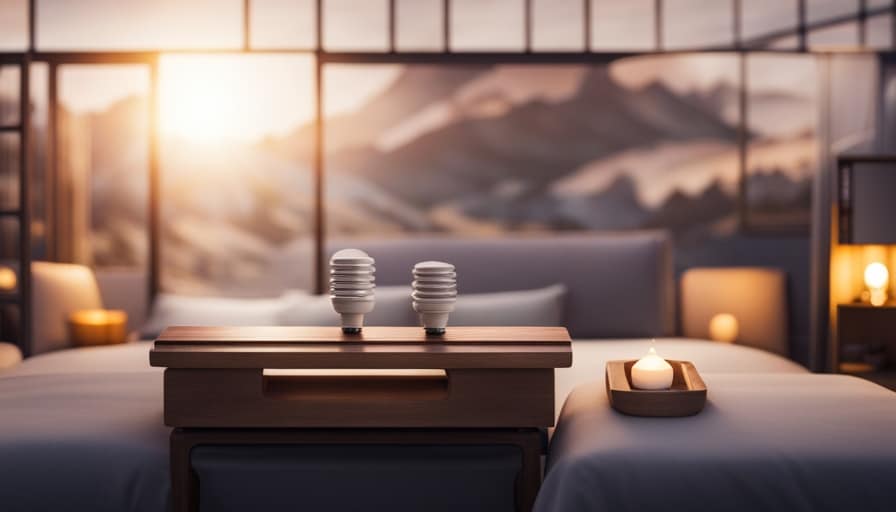
-
Murphy bed with a built-in desk: This clever furniture piece served as a cozy sleeping area at night and transformed into a functional workspace during the day, complete with a desk and storage shelves.
-
Nesting tables: These stylish and practical tables could be stacked together when not in use, taking up minimal space, and easily pulled out when we needed extra surface area.
By utilizing these space-saving multipurpose furniture pieces, we were able to create a comfortable and functional living environment in our tiny house.
Now, let’s move on to discuss creative storage solutions to further optimize our small space.
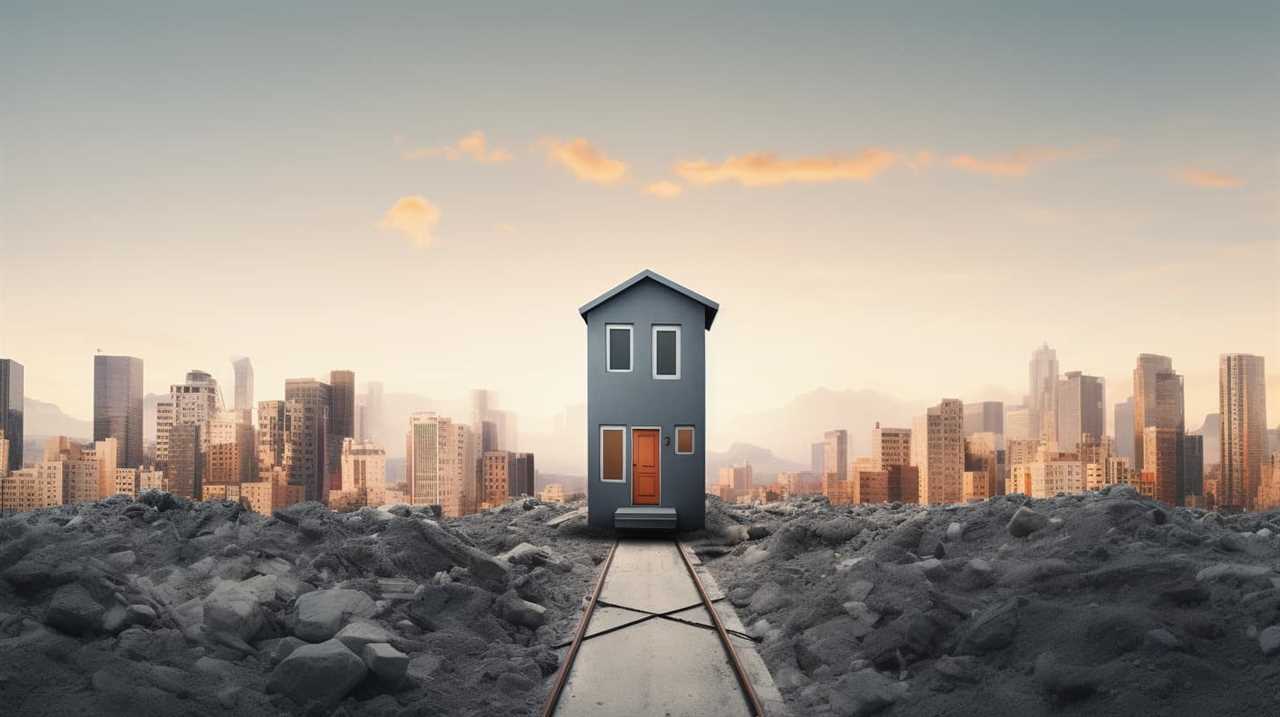
Creative Storage Solutions
To maximize storage in our tiny house, we utilized innovative furniture solutions and came up with creative storage solutions. In our search for hidden compartments and clever organization, we discovered some ingenious ways to make the most of our limited space.
One of our favorite solutions is a wall-mounted table with built-in shelves. This multipurpose piece of furniture serves as a dining table, a workspace, and provides additional storage for books and knick-knacks.
Another clever idea we implemented is a bed with drawers underneath. This allows us to store extra linens, clothing, and personal items, keeping them out of sight but easily accessible.
Additionally, we found that using furniture with built-in storage, such as ottomans with hidden compartments or coffee tables with drawers, helped us maximize every inch of our tiny house.

Embracing Minimalism
We can start embracing minimalism by decluttering our possessions and simplifying our lives. Adopting a minimalist lifestyle can bring a sense of calm and freedom to our tiny house living.
Here are four decluttering techniques to help us get started:
-
Begin with a mindset shift: Understand that material possessions don’t define our happiness. Focus on experiences and relationships instead.
-
Sort and categorize: Start by going through each room and separating items into three categories – keep, donate/sell, and discard. Be ruthless and only keep what truly serves a purpose or brings joy.
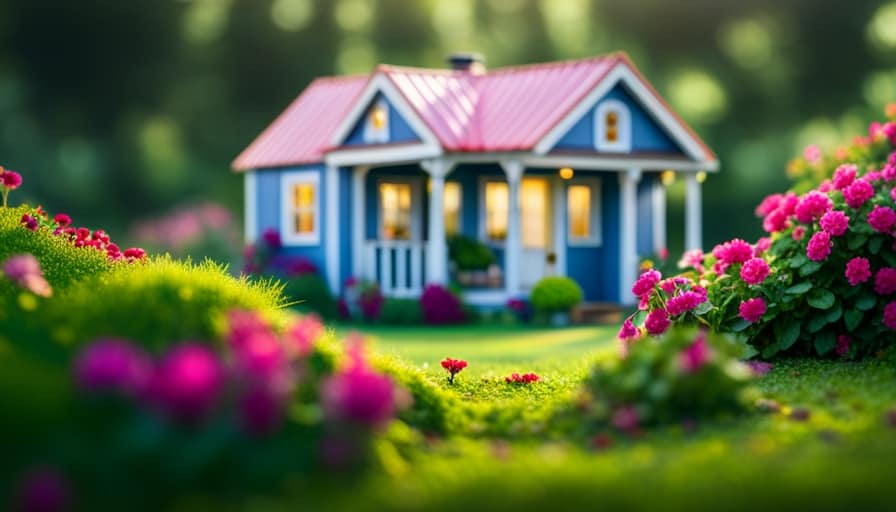
-
Utilize storage solutions: Invest in smart storage options such as under-bed storage, wall-mounted shelves, and multi-purpose furniture to maximize space and minimize clutter.
-
Practice the one-in, one-out rule: For every new item we bring into our tiny house, get rid of something else. This helps maintain a clutter-free environment.
Designing for Multi-functionality
When it comes to living in a tiny house, one of the key considerations is designing for multi-functionality. This means finding ways to make the most of every inch of space available.
Some space-saving furniture ideas include foldable tables, sofa beds, and wall-mounted shelves. Additionally, maximizing storage solutions such as under-bed storage, hidden cabinets, and built-in organizers can help keep the space clutter-free.
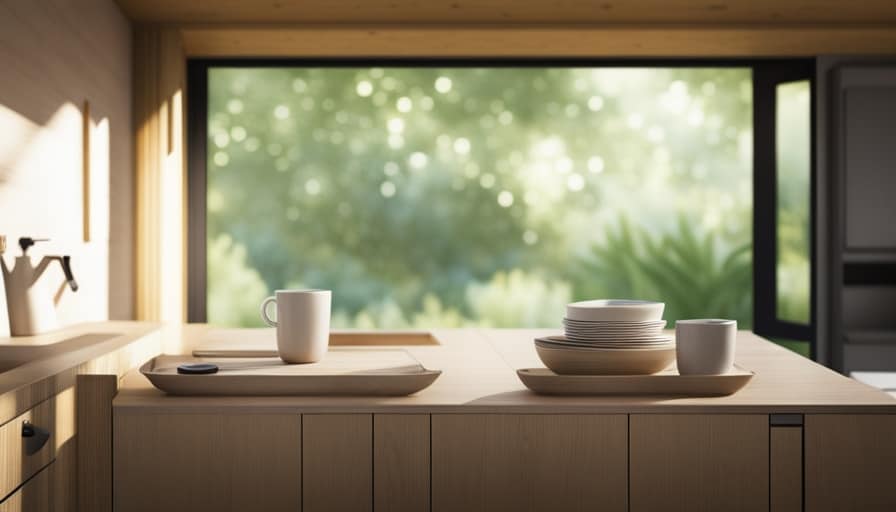
However, it’s important to strike a balance between aesthetics and functionality to ensure that the tiny house remains a comfortable and inviting space to live in.
Space-Saving Furniture Ideas
With limited space, our tiny house requires furniture that serves multiple purposes. We need compact storage options and folding furniture designs to maximize the use of every square inch. Here are four space-saving furniture ideas that can make a big difference in a small living space:
-
Wall-mounted foldable table: This versatile piece can be used as a dining table, desk, or even a space to prep meals. When not in use, simply fold it against the wall to free up valuable floor space.
-
Sofa bed: A sofa that can transform into a bed is a perfect solution for accommodating overnight guests. During the day, it provides comfortable seating, and at night, it easily converts into a cozy bed.
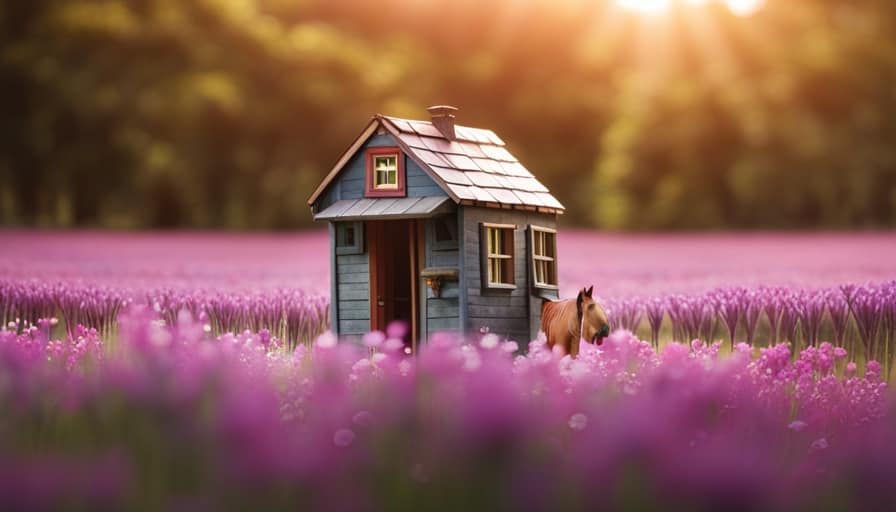
-
Storage ottoman: This multifunctional piece can serve as a footrest, extra seating, and hidden storage. It’s a great way to keep your belongings organized and out of sight.
-
Murphy bed: A classic space-saving solution, a Murphy bed folds up against the wall when not in use, allowing you to use the room for other activities during the day.
Maximizing Storage Solutions
The key to maximizing storage solutions in our tiny house is to design for multi-functionality. In order to make the most of the limited space available, we need to think creatively and come up with innovative storage solutions.
One idea is to utilize vertical space by installing shelves or hanging organizers on the walls. This allows us to store items without taking up valuable floor space.
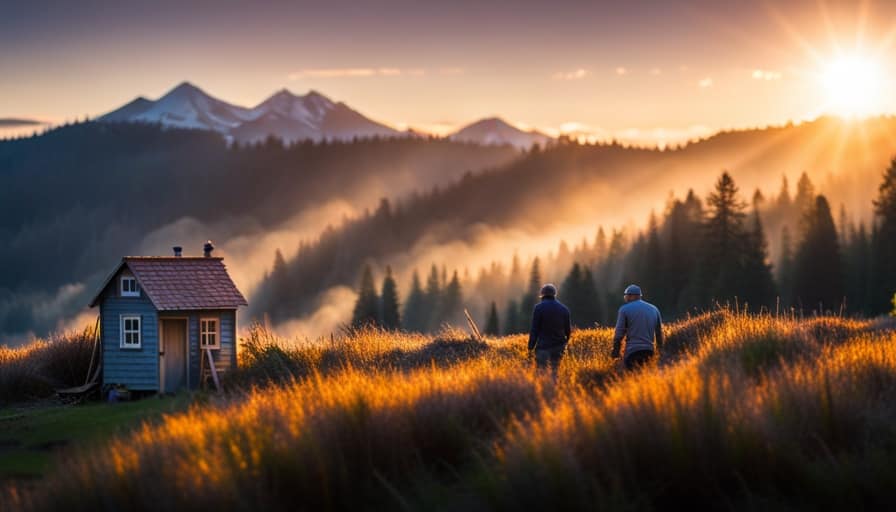
Another space-saving design idea is to use furniture with built-in storage compartments, such as ottomans or bed frames with drawers. This way, we can have functional furniture that also provides hidden storage.
Additionally, we can make use of underutilized areas, such as the space under the stairs or above the kitchen cabinets, by installing custom shelves or cabinets.
Balancing Aesthetics and Functionality
To achieve a harmonious living space in our tiny house, we strive to balance aesthetics and functionality by designing for multi-functionality. Here are four ways we achieve this balance:
-
Integrating nature: We bring the outdoors inside by incorporating natural elements into our design. Adding plants, using organic materials, and maximizing natural light create a sense of connection with nature and promote a calm and peaceful atmosphere.

-
Incorporating personal style: We believe that our tiny house should reflect our unique personalities and preferences. By incorporating personal style through furniture, decor, and color choices, we create a space that feels like home and brings us joy.
-
Maximizing use of space: In a tiny house, every square inch counts. We design our furniture and storage solutions to be multifunctional, maximizing the use of space. For example, a sofa can also double as a guest bed, and a dining table can fold away when not in use.
-
Prioritizing simplicity: To maintain a visually appealing and functional space, we prioritize simplicity in our design choices. By keeping clutter to a minimum, organizing our belongings effectively, and choosing clean lines and minimalistic decor, we create a sense of spaciousness and serenity in our tiny house.
Creating Outdoor Living Spaces
We love incorporating cozy fire pits into our outdoor living spaces. They create a warm and inviting atmosphere for outdoor entertaining, perfect for small gatherings and intimate conversations.
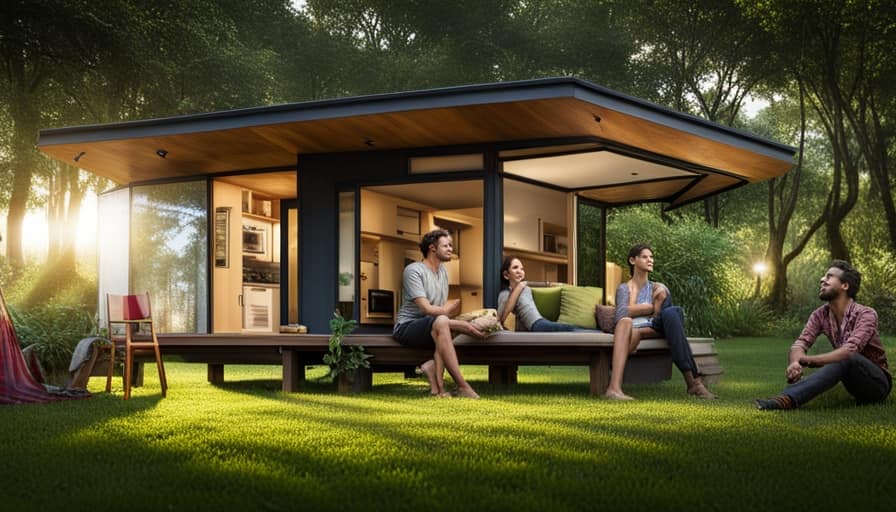
When designing our garden, we prioritize functionality and aesthetics. We consider the layout and flow, ensuring that there’s enough space for seating areas, dining spaces, and even a small herb garden.
To maximize the use of our outdoor space, we utilize vertical gardening techniques, hanging plants and installing trellises for climbing vines. This not only adds beauty to our garden design but also maximizes the available space.
Additionally, we incorporate versatile furniture that can serve multiple purposes, such as storage benches that double as seating.
Utilizing Vertical Space
By installing floating shelves and using wall-mounted organizers, we can make the most of our vertical space in a tiny house. Utilizing vertical space is essential for maximizing storage and functionality in small living spaces. Here are four tips to help you make the most of your vertical space:

-
Vertical gardening: Utilize your walls to create a stunning vertical garden. Install hanging planters or vertical gardening systems to grow herbs, flowers, and even vegetables. Not only does this add beauty to your tiny house, but it also provides fresh produce and improves air quality.
-
Space-saving appliances: Invest in compact and multi-functional appliances that can be mounted on your walls. Wall-mounted microwaves, dish racks, and even foldable dining tables can help save valuable floor space and create a clutter-free environment.
-
Floating shelves: Install floating shelves on your walls to store books, decor items, and kitchen essentials. This not only adds storage but also acts as a decorative element, showcasing your personal style.
-
Wall-mounted organizers: Use wall-mounted organizers to keep your belongings organized and easily accessible. Install hooks for hanging coats, hats, and bags, and use pegboards or grid panels to hang tools, utensils, and other small items.
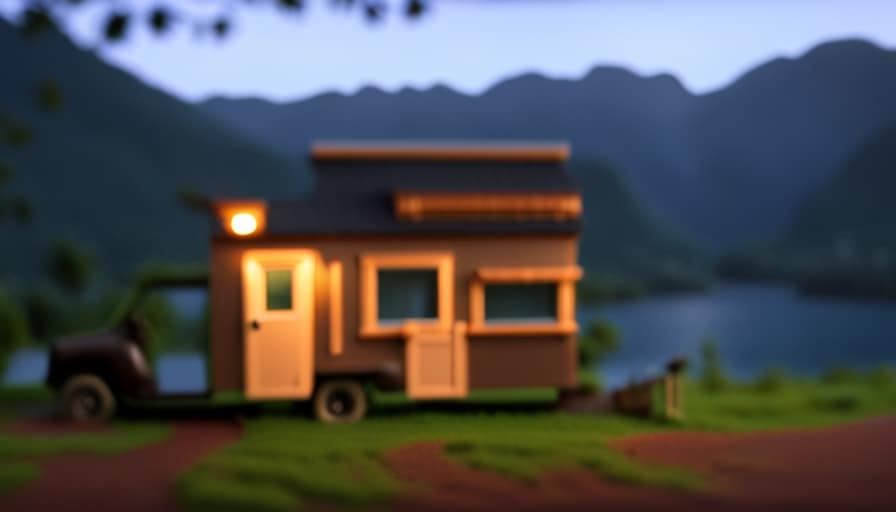
Harnessing Natural Light
When it comes to tiny house living, harnessing natural light is essential for creating a bright and spacious feel. One way to achieve this is by maximizing window placement, allowing sunlight to flood into the space.
Another tip is to use reflective surfaces, such as mirrors or glossy finishes, to bounce light around the room.
Additionally, choosing light-colored furnishings can help to enhance the natural light and make the space appear even more open and airy.
Maximizing Window Placement
Let’s make sure we maximize the placement of windows in our tiny house to harness the natural light. Having ample windows not only brightens up the space, but it also creates a sense of openness and connection with the outdoors. Here are some tips to consider for maximizing window placement:
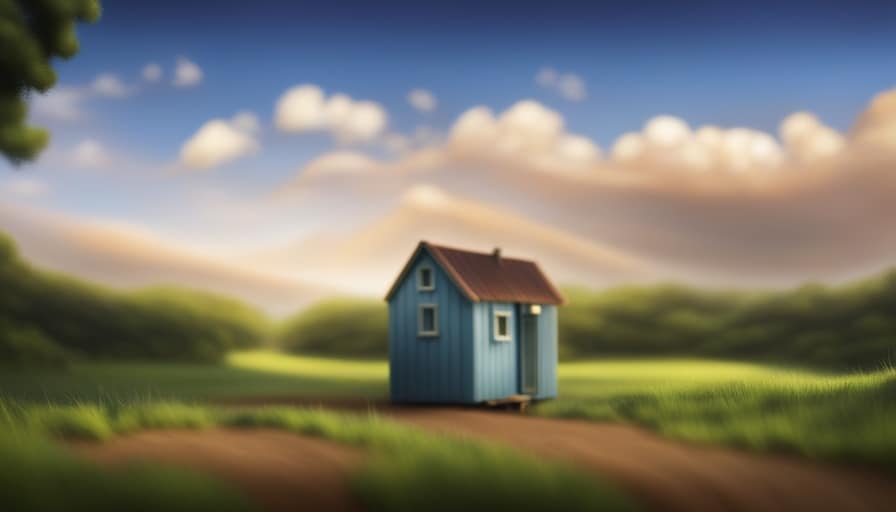
- Strategically position windows to take advantage of the best views and natural light throughout the day.
- Use large windows or floor-to-ceiling windows to create a sense of spaciousness and maximize natural light intake.
- Consider incorporating window treatments, such as sheer curtains or blinds, that allow natural light to filter through while still providing privacy.
- Install windows on multiple walls to ensure cross-ventilation and maximize airflow.
By carefully considering window placement and utilizing these window treatment ideas, we can maximize natural views and create a bright and welcoming tiny house.
Now, let’s move on to the next section to explore the use of reflective surfaces to further enhance the natural light in our space.
Using Reflective Surfaces
To create a brighter and more spacious ambiance, we can enhance the natural light in our tiny house by using reflective surfaces and incorporating them strategically throughout the space. Reflective decor, such as mirrors, can be incredibly effective in maximizing the amount of light in a small area. By strategically placing mirrors opposite windows or light sources, we can bounce light around the room, creating the illusion of a larger space and making it feel more open and inviting. Mirrors can also be used to visually expand cramped areas, such as hallways or corners, by reflecting light into those areas. Additionally, using reflective surfaces on furniture or accessories can help to scatter light and create a brighter atmosphere. By incorporating these simple techniques, we can harness the power of natural light and transform our tiny house into a bright and spacious haven.
| Benefits of Using Reflective Surfaces |
|---|
| 1. Maximizes natural light |
| 2. Creates the illusion of a larger space |
| 3. Brightens up dark corners |
| 4. Adds depth and dimension to the room |
| 5. Enhances the overall ambiance |
Choosing Light-Colored Furnishings
By selecting light-colored furnishings, we can effectively harness natural light and create a bright and airy atmosphere in our tiny house. Light-colored walls and furnishings reflect natural light, making the space feel larger and more open.

Here are four reasons why choosing light-colored furnishings is essential for small space organization:
-
Enhances Natural Light: Light-colored furnishings bounce off natural light, maximizing its reach and making the space feel brighter and more inviting.
-
Creates Illusion of Space: Light colors create an optical illusion of a larger space, making your tiny house feel more open and spacious.
-
Highlights Other Design Elements: Light-colored furnishings act as a blank canvas, allowing other design elements such as artwork and decorative accents to stand out.
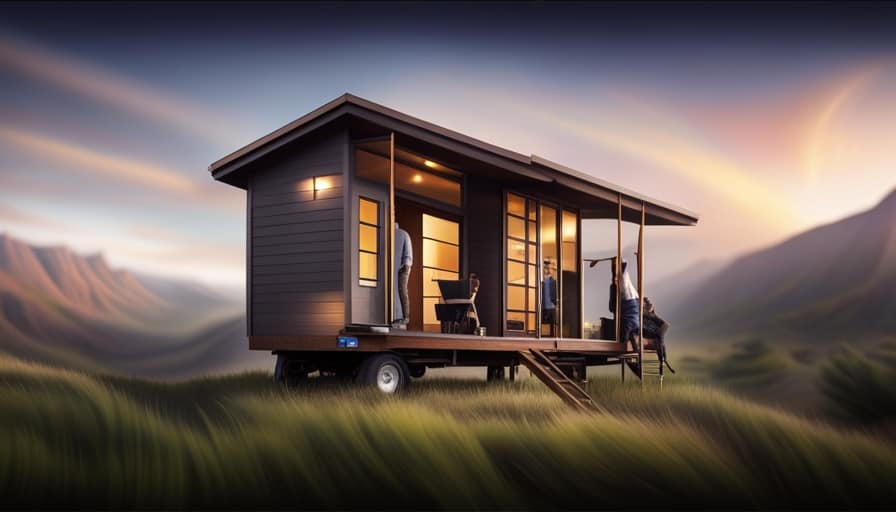
-
Promotes Serenity: Light colors have a calming effect, creating a peaceful and serene environment in your tiny house.
Incorporating Smart Technology
One of the top 10 tips for tiny house living is to incorporate smart technology into our daily routines. Smart home automation can greatly enhance the functionality and efficiency of our small living spaces. By using smart devices, we can control various aspects of our home, such as lighting, temperature, and security, all from the convenience of our smartphones or voice commands.
This not only adds convenience but also helps us save energy and reduce our carbon footprint. For example, we can program our smart thermostats to adjust the temperature based on our schedule, ensuring that we only use energy when needed. Additionally, smart lighting systems can automatically turn off lights in unoccupied rooms, further maximizing energy efficiency.
Efficient Heating and Cooling Systems
We can maximize our comfort and energy efficiency in tiny house living by choosing efficient heating and cooling systems. Here are four tips to help you create an efficient environment:

-
Invest in efficient insulation: Properly insulating your tiny house can significantly reduce the amount of energy needed to heat or cool it. Consider using materials such as spray foam insulation or double-pane windows to minimize heat loss or gain.
-
Explore renewable energy sources: Harnessing the power of the sun or wind can provide a sustainable and cost-effective way to heat and cool your tiny house. Solar panels or small wind turbines can generate electricity to power your heating and cooling systems.
-
Opt for compact and efficient HVAC units: Look for heating and cooling systems specifically designed for small spaces. Mini-split air conditioners and heat pumps are compact and energy-efficient options that can provide both heating and cooling.
-
Use smart thermostats: Install programmable thermostats that allow you to set temperature schedules based on your daily routine. This way, you can optimize energy usage and maintain a comfortable indoor climate.
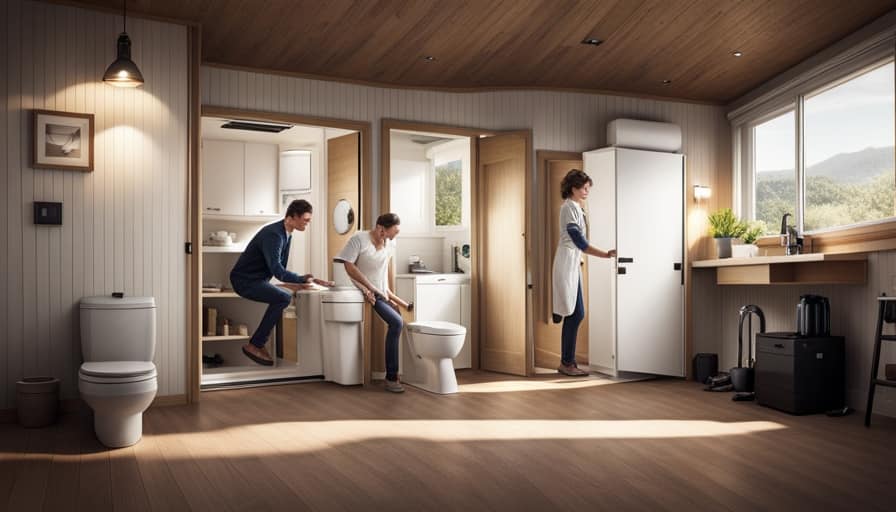
Sustainable Living Practices
While living in a tiny house, it’s important for us to incorporate sustainable living practices into our daily routines.
One way we can do this is by utilizing green energy sources. Installing solar panels on the roof of our tiny home can help us generate clean and renewable energy, reducing our reliance on fossil fuels.
Additionally, we can invest in energy-efficient appliances and LED lighting to further minimize our energy consumption.
Another aspect of sustainable living in a tiny house is the use of sustainable materials. Opting for materials that are eco-friendly, such as reclaimed wood or bamboo flooring, not only reduces our environmental impact but also adds a unique and natural touch to our living space.
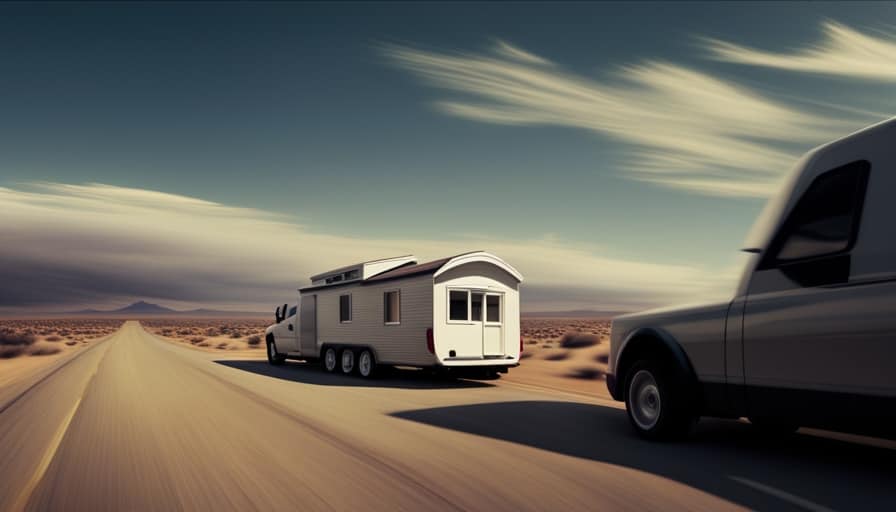
Frequently Asked Questions
What Are Some Tips for Choosing the Right Location for a Tiny House?
Choosing the right location for a tiny house is crucial. Consider zoning laws, climate, utilities, amenities, accessibility, surroundings, privacy, community, future growth, and cost of living. These factors will help ensure a successful living experience.
How Can I Incorporate My Personal Style and Design Preferences Into a Tiny House?
Incorporating personal style and design preferences into a tiny house requires creativity and practicality. We can achieve this through creative storage solutions and multi-functional furniture options, making the most of our limited space.
Are There Any Safety Considerations to Keep in Mind When Living in a Tiny House?
When living in a tiny house, safety measures are crucial. It’s important to consider fire prevention by installing smoke detectors and fire extinguishers. Regularly check electrical wiring and appliances for any potential hazards.
What Are Some Common Challenges or Obstacles That People Face When Transitioning to Tiny House Living?
Transitioning to tiny house living can present common challenges and obstacles. From downsizing possessions to adjusting to limited space, it requires careful planning and organization. However, with proper preparation and a positive mindset, these challenges can be overcome, leading to a fulfilling and simplified lifestyle.
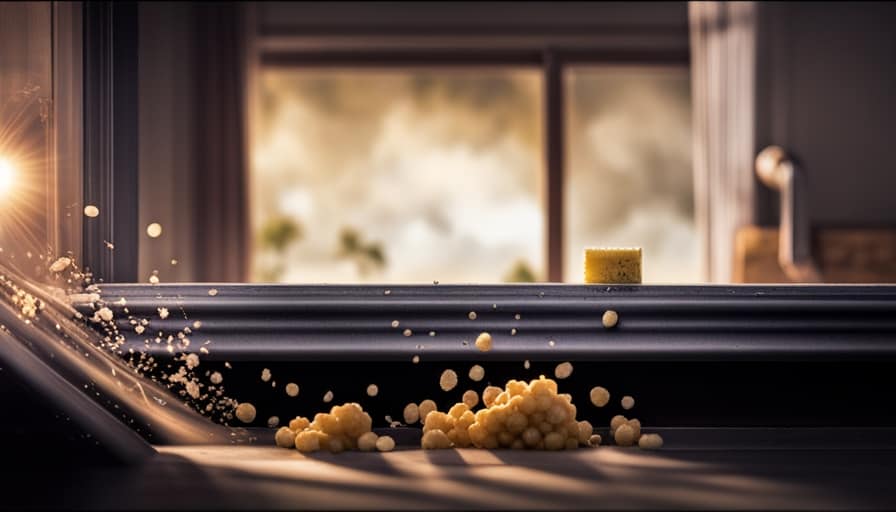
How Can I Maintain a Sense of Privacy and Separation of Spaces in a Tiny House?
Maintaining privacy and separation of spaces in a tiny house can be challenging. We have found privacy solutions like curtains or room dividers, and space maximizing techniques such as loft beds or folding furniture to be effective.
Conclusion
In conclusion, by following these top 10 tips for tiny house living, we can maximize storage space, embrace minimalism, and create outdoor living spaces.
By harnessing natural light and incorporating smart technology, we can enhance our living experience.
Additionally, efficient heating and cooling systems and sustainable living practices ensure a comfortable and eco-friendly lifestyle.
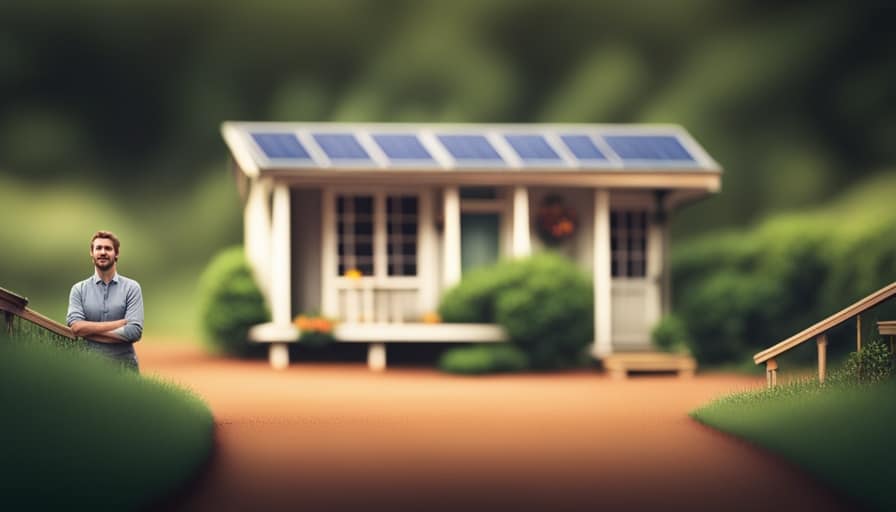
So, let’s live small, dream big, and make the most out of our tiny house living.
I’m Theodore, and I love tiny houses. In fact, I’m the author of Tiny House 43, a book about tiny houses that are also tree houses. I think they’re magical places where imaginations can run wild and adventures are just waiting to happen.
While tree houses are often associated with childhood, they can be the perfect adult retreat. They offer a cozy space to relax and unwind, surrounded by nature. And since they’re typically built on stilts or raised platforms, they offer stunning views that traditional homes simply can’t match.
If you’re looking for a unique and romantic getaway, a tree house tiny house might just be the perfect option.

